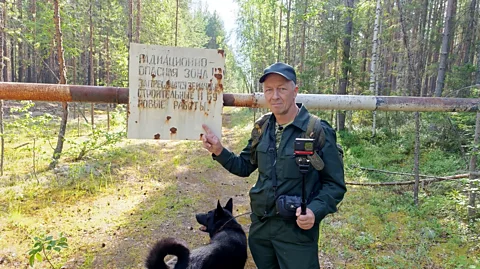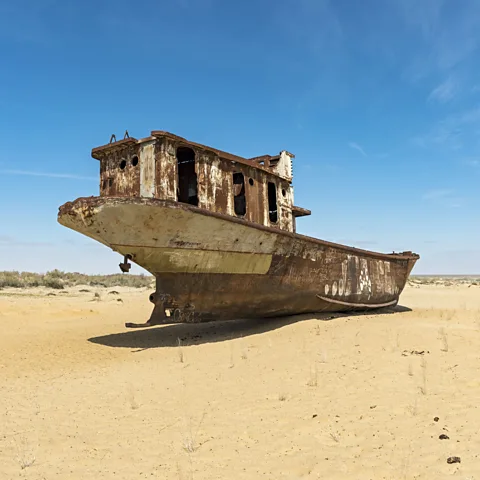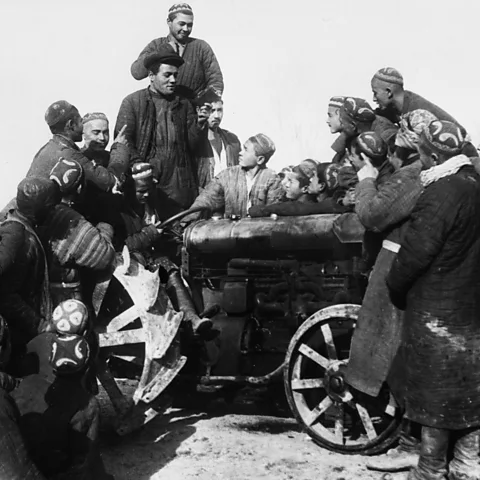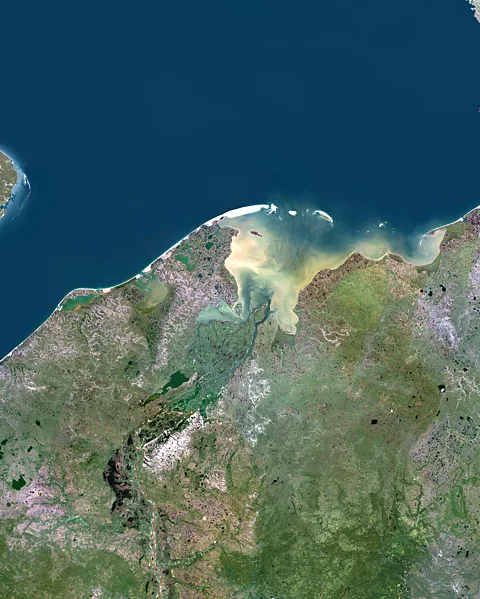The Soviet plan to reverse Siberia's rivers with 'peaceful nuclear explosions'
The final countdown began: …3, 2, 1, 0… then fountains of soil and water shot upward – Leonid Volkov
In this case, the blasts were supposed to help excavate a massive canal to connect the basin of the Pechora River with that of the Kama, a tributary of the Volga. Such a link would have allowed Soviet scientists to siphon off some of the water destined for the Pechora, and send it southward through the Volga. It would have diverted a significant flow of water destined for the Arctic Ocean to go instead to the hot, heavily populated regions of Central Asia and southern Russia.
This was just one of a planned series of gargantuan "river reversals" that were designed to alter the direction of Russia's great Eurasian waterways. Redirection was intended to alter not just the Volga, but also several Siberian rivers, sending water thousands of kilometres southward via canals and reservoirs.

 Andrei Fadeev
Andrei Fadeev
Years later, Leonid Volkov, a scientist involved in preparing the Taiga explosions, recalled the moment of detonation. "The final countdown began: …3, 2, 1, 0… then fountains of soil and water shot upward," he wrote. "It was an impressive sight." Despite Soviet efforts to minimise the fallout by using a low-fission explosive, which produce fewer atomic fragments, the blasts were detected as far away as the United States and Sweden, whose governments lodged formal complaints, accusing Moscow of violating the Limited Test Ban Treaty.
Fifty years later, Nuclear Lake is a half-forgotten tourist curiosity. But it is also a physical reminder of one of the Soviet Union's last megaprojects – river reversal – and the extraordinary lengths to which the Kremlin was prepared to go to make it happen.
The idea of using canals and dams to redirect freshwater from Russia's north-flowing rivers had been around for a century by the time of the blasts, tempting successive Russian regimes. Perhaps most famously, it was proposed by writer Igor Demchenko in an 1871 booklet called: "On flooding the Aral-Caspian lowlands to improve the climate of adjacent countries." Later, it was raised as a possibility by Soviet planners under Stalin in the 1930s.
The appeal was simple: some of the huge volumes of water flowing through Siberia and northern Russia could be "utilised" by sending them to the more arid lands of Central Asia and southern Russia. Agriculture is a lucrative prospect in the Eurasian heartlands, where there are many more people than the freezing Russian north. The redirected water, planners hoped, could also help save the Aral Sea, which had seen catastrophic water loss in recent decades because its tributaries were over-exploited for agriculture.
For Russia's rulers, "this huge flow of water into the Arctic Ocean was going nowhere useful", says Douglas Weiner, an historian at the University of Arizona specialising in Soviet environmental policy. "It's this big bauble of a resource that's not being used. It's a huge resource. So, there is always this tempting idea that we can somehow find a way to use it.
The closest the Soviet Union came to realising river reversal was in the 1970s and early 1980s. In this period, hundreds of millions of rubles were poured into developing the project, which involved nearly 200 scientific research institutes, enterprises, and scientific production organisations, and, according to some estimates, 68,000 people.

 Getty Images
Getty Images
Not only did Soviet ideology suggest that nature could be transformed into a rational tool to help build socialism, but prestige projects were a key part of Cold War competition with the West. Plus, demand for water was skyrocketing. "This period saw the active development of irrigated agriculture, it became clear that our own resources of water were insufficient, populations were growing, and existing production technologies were quite water-intensive," says Mikhail Bolgov, a surface water expert at Russia's Institute for Water Problems (this Institute, which still operates in Russia today, was a leading advocate for river reversal during the Soviet period). "And there was already an understanding that the Aral Sea would disappear if irrigation was continued at such a scale."
Soviet planners were inspired by history's great water amelioration projects from history (including Roman aqueducts), and claimed they did not want to redirect whole rivers, just a small percentage of the water in Siberian river basins. Finally, they believed that they might be able to save not only the Aral Sea, but also the Caspian Sea and the Azov Sea, which were both also recording significant drops in water level.
It boggled my mind to see such conclusions as 'we anticipate local and manageable environmental impacts' – Paul Josephson
At the same time, river reversal was a colonial project, appealing both to those in the Kremlin with imperialist views, as well as local leaders in the Central Asian republics who believed it would be a way of channelling money and influence. "[It] was connected with bringing modern technology and Slavic settlers to those regions as a way of incorporating them," says Paul Josephson, a professor of Russian and Soviet history at Colby College in Waterville, Maine
Many were bewitched by the sheer ambition. "The same magic of its big scale was supposed to infinitely inspire its advocates and belittle its opponents," wrote the leading Soviet opponent of the scheme, hydrologist and writer Sergei Zalygin, in his 1986 book Turnabout. "We are the greatest and you are against us – how could that be?!"
In addition to the Volga, those labouring over river reversal in the 1970s focused on two Siberian rivers – the Ob and Irtysh. They planned the construction of a 1,500km-long (930-mile) canal using hundreds of PNEs that would, when completed, channel up to 10% of the water from the basins of the Ob River and Irtysh River to Kazakhstan, Uzbekistan and Turkmenistan. A Communist Party resolution in May 1975 envisaged Siberian water would first arrive in Central Asia in 1985, and that the whole project would be completed by 2000.
It wasn't to be. From the moment serious discussions about river reversal began, there was opposition from scientists and experts. In the early 1980s, however, this opposition spiralled into the sort of broad-based public campaign that was highly unusual in the tightly controlled Soviet Union. There were essays in journals, letters to officials, even novels and poems about the folly of the project. In Ballad About Freedom, Soviet poet Fazil Iskander wrote: "It's completely impossible to know what's going on in the head of the regime / whether they want to wring the neck of the northern rivers, or steal the Gulf Stream!"
Intellectuals like Zalygin raised a whole series of objections – from the project's eye-watering cost that may have run to the hundreds of billions of dollars, to its wastefulness, settlements and culturally significant sites that would have been flooded, the flawed science they alleged lay at its heart, bureaucratic self-aggrandisement, along with a myriad of potentially devastating environmental consequences.
Historian Josephson says that, when he did research at the Institute for Water Problems in Moscow in the late 1980s, he was permitted by the then-director, Grigory Voropaev, a leading advocate for the scheme, to see the official environmental impact report. It was, Josephson realised, completely inadequate. "It boggled my mind to see such conclusions as 'we anticipate local and manageable environmental impacts'," Josephson says.

 Getty Images
Getty Images
In fact, there were concerns that diverting the water southward could mean anything from the destruction of unique habitats, to dangerous climatic change, says Josephson. "Ice would set on southward into the rivers earlier and deeper into Siberia. There would be flora and fauna that would transfer from Siberia to Central Asia. There are just so many things that could have happened," he says. "The intellectuals, whether they were trained in biology and environment, or literary types, understood that the scale of the project made it impossible to contain in terms of its environmental impact."
Perhaps the final nail in the coffin was the Chernobyl nuclear disaster in 1986, which not only consumed a huge amount of money, but pushed environmental concerns up the political agenda. Four months after the Number Four Reactor at the Chernobyl Nuclear Power Plant exploded, Soviet Premier Mikhail Gorbachev cancelled the river reversal project. While some have said this was the result of the public pressure, others believe it was the astronomical cost – at a time when depressed oil prices were causing financial problems for the Kremlin. "Everything was set to go," says historian Weiner. "But realistically I don't think they would have done it because they didn't have the money."
It may have seemed that river reversal as a serious prospect died with the Soviet Union, which collapsed five years later. But advocates for the project in senior positions in the Russian government continued to speak out in its defence. In 2008, for example, then Moscow Mayor Yuri Luzhkov published a book called "Water and Peace" that argued in favour of re-directing Siberian rivers to Central Asia.
And, as recently as February 2025, two Russian scientists argued in an article in Russian daily newspaper Nezavisimaya Gazeta that technical advances since the 1980s make river reversal more feasible, and that it aligns well with Moscow's geopolitical "pivot to the East" that has followed the breakdown in relations with the West over the full-scale invasion of Ukraine.
Some academics in both Russia and the West have even suggested that reducing the amount of relatively warm water flowing into the Arctic Ocean could help mitigate the effects of global warming. But this is strongly disputed by others, who say it would have the complete opposite effect.

 Getty Images
Getty Images
Tom Rippeth, a professor of physical oceanography at Bangor University in Wales, published a paper in 2022 modelling the effects of Siberian river reversal, which showed it could have disturbed the structure of the Arctic Ocean, causing a warmer, saltier layer of water to rise, and dramatically accelerated the melting of sea ice. "If you upset nature's balance, there are a lot of unintended consequences," he says.
Despite a present lull in political interest in river reversal, historian Josephson predicts that, one day, the idea will resurface – although perhaps with China substituted for Central Asia as a destination for Russian water. "The project will not die," he says. "Russia is a resource empire – it survives by selling its resources. So, it makes sense for Russia, ultimately, in some place and time, to work with the Chinese to transfer water from Siberia across the border to farming regions of northern China."
Even some of those who successfully campaigned in the 1980s to stop the Soviet Union from diverting the great Eurasian waterways were never convinced their victory was final. In their book Lessons of Ecological Failures, Soviet academics Alexander Yanshin and Arkady Melua argued that river reversal would, one day, make a comeback – not least because of competition over water, and rising populations in Central Asia.
"The question about diverting some of the sources of Siberian rivers to Central Asia will most likely be raised again in the third millennium," they wrote in 1991. "However, it's obvious that this will require the development of another project."
Ultimately, the nuclear explosions that created Nuclear Lake, one of the few physical traces left of river reversal, were deemed a failure because the crater was not big enough. Although similar PNE canal excavation tests were planned, they were never carried out. In 2024, the leader of a scientific expedition to the lake announced radiation levels were normal.
But blogger Fadeev says there were some places where the radiation was still significantly elevated – almost half a century after the blasts. After having done a lot of research into radiation, he decided to remain cautious. "I didn't go for a swim," he says.
--
For essential climate news and hopeful developments to your inbox, sign up to the Future Earth newsletter, while The Essential List delivers a handpicked selection of features and insights twice a week.









